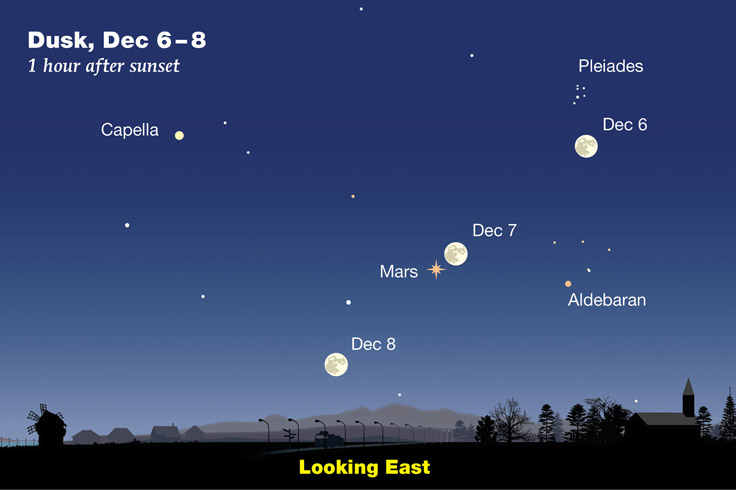December’s solstice means that for many skywatchers the night will be up to 14 hours long — providing lots of time to enjoy the starry sky. This month’s celestial highlights are the close approach of the Moon and Mars (and, for many, a coverup) on December 7th and the Gemind meteor shower on the December 13th. Our fun and factual Sky Tour podcast provides all the details.

Listen Here:
Podcast: Play in new window | Download
Subscribe: Apple Podcasts | Google Podcasts | Spotify | Email | RSS | More
December’s solstice occurs on the 21st at 4:48 p.m. Eastern Standard Time. This Latin word means “Sun stands still,” and it marks a celestial turnaround point. At that moment the Sun has traveled its farthest south in the sky, shining directly down on Earth’s Tropic of Capricorn in the Southern Hemisphere, and then it reverses direction to gradually move northward among the stars. Weather-wise, this date marks the astronomical beginning of summer in the Southern Hemisphere and of winter up here in the north. For those of us at mid-northern latitudes, around this solstice the span from sunset to sunrise is at least 14 hours. That’s great for stargazing, of course, but a little depressing if you love being out in the sunshine.

Sky & Telescope
The full Cold Moon occurs the night of the 7th, with the Moon and Mars very close together in the sky. They’re so close, in fact, that the Moon will slide right over Mars (what’s called an occultation) as seen from much of North America. In the contiguous United States, the coverup will be visible north of a line that runs roughly from Dallas, Texas, across central Kentucky and Pennsylvania, and through Massachusetts. Anyone south of that line will see Mars skim oh so very close to the Moon’s southern edge.
Toward the end of December, you’ll have the chance to view all five bright planets at once. Mercury and Venus will be peeking above the southwestern horizon shortly after sunset. Venus will be quite low down but very bright, and Mercury will be just to its upper left. If you manage to spot them in the deepening dark, let your gaze slide even farther to the left to sweep up Saturn, then Jupiter, and finally Mars way over in the east. Congrats — that’s a five-fecta of bright planets!
December also features the return of the Geminid meteor shower. From a clear, dark location, far from strong sources of light pollution and moonlight, you might see one meteor per minute or more when it peaks on the night of December 13th. That evening the waning gibbous Moon and its intrusive light will be out out of view until about 9 or 10 pm; by then Gemini will already be well up and the show of shooting stars should already be under way.
Meanwhile, this month the bright stars of northern winter begin their parade across the evening sky. Early in December, by around 7 p.m., the majestic stars of Orion veritably leap up over the eastern horizon. By month’s end, those same stars come into view a couple of hours earlier, soon after sunset.
This is just a taste of the entertaining and educational skywatching tips you’ll get by listening to this month’s Sky Tour podcast. It’s designed to provide a pleasant, casual, and yet informative romp across the nighttime sky. No experience or equipment is needed! Instead, all you need is a little curiosity, a clear sky, and December’s Sky Tour episode.
 0
0
Comments
You must be logged in to post a comment.